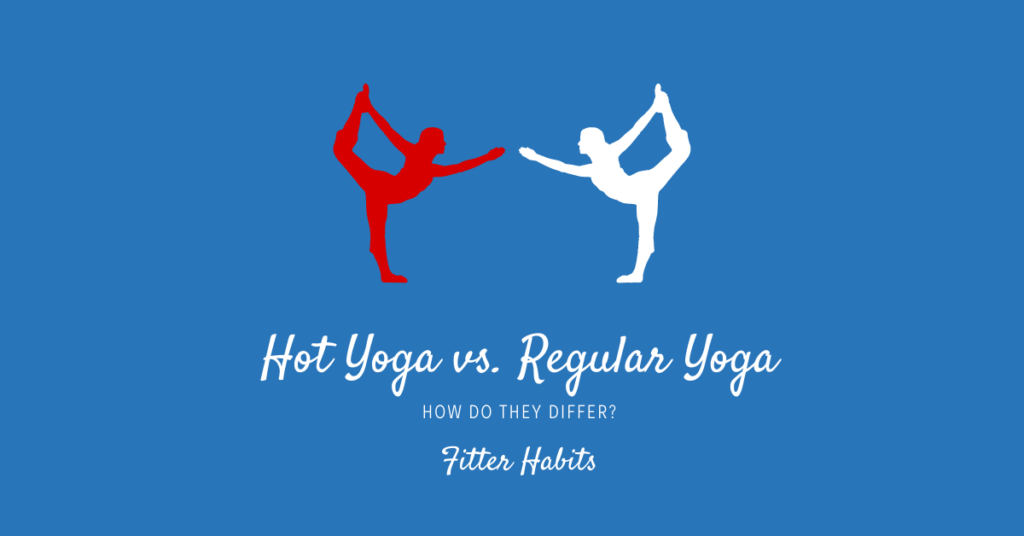Have you found yourself considering hot yoga vs regular yoga? Let’s start with defining hot yoga. Hot yoga is any kind of hatha yoga (yoga as exercise) that you do in a heated room, usually ranging from 80-105⁰F.
The most common types are Bikram yoga, hot vinyasa-style yoga and hot power yoga, but it’s also possible to find classes teaching slower and lower-impact kinds of yoga such as Yin yoga.
So what’s the heat for, and is it really as good for you as they say? In this article we explore hot yoga vs. regular yoga; let’s see how these two types of yoga compare.
Contents
What are the Benefits of Hot Yoga?
Those who swear by hot yoga say it burns calories, helps get rid of fat, clears up their skin and gets their hearts pumping. For many, it’s the perfect balance between a workout that is easy on the joints and one that makes them sweat.
While little scientific data backs up the supposed benefits, you won’t find it hard to believe that hot yoga feels good. You might be among the many who believe, it’s what an ideal workout looks like: holding yoga poses for a long time in a hot, humid room while breathing mindfully and pressing their bodies to its limits.
This description makes it easy to see why the satisfaction of a completed hot yoga session could bring you back for more.
You might also find our yoga vs. CrossFit guide useful.
A Closer Look at Hot Yoga

Pros:
1. Burns calories promoting weight loss
A 2014 study from Colorado State University (CSU) showed that a 90-minute session of Bikram yoga burned an average of 460 calories for men and 330 for women. However, there is no evidence that hot yoga burns more calories than regular yoga.
2. Good for your skin
Similar to a sauna, the heat and humidity of a hot yoga studio may help rejuvenate your skin by opening the pores and bringing oxygen-rich blood to the surface. Many hot yoga students come back for this detoxification effect when their skin is looking dull.
3. Can make you more flexible
The heated environment of a hot yoga class surrounds your muscles with warm, moist air, which can help you stretch deeper into each asana. This is especially true in Bikram yoga classes, where yoga practice takes place in a 105-degree room at 40 percent humidity. In the CSU study mentioned above, hot yoga improved spine, hamstring and shoulder flexibility in its test subjects practicing in Bikram studios.
4. Greater sense of accomplishment
Because of the sheer difficulty of completing an intense hot yoga session, you might feel a greater sense of accomplishment at the end compared to a neutral-temperature yoga class.
Cons:
1. Not necessarily better for you
Although hot yoga has its perks, no data shows that a hot yoga routine offers better health benefits than a regular yoga routine of the same regularity. Existing research suggests that hot yoga is still considered “low-intensity” in terms of oxygen consumption. It’s comparable to a long, brisk walk.
2. Can be risky for certain groups
Because a heated class can place students at a higher risk for heatstroke or exhaustion, hot yoga isn’t considered safe for those who are pregnant or have health conditions such as high blood pressure, diabetes or cardiovascular issues.
Remember that hydration is important during a hot yoga session, as you will be losing a lot of water and electrolytes as you sweat.
A Closer Look at Regular Yoga

Pros:
1. Backed by Science
In contrast to hot yoga, room temperature yoga has a growing body of research supporting its benefits for physical and emotional wellness. It’s possible to achieve many of the same benefits that hot yoga offers by performing the same styles of yoga at a normal temperature. Yoga can tone muscle, increase range of motion and possibly even prevent heart disease.
2. Less Risk to Your Health
Unheated yoga is not associated with the same risks of dehydration, heatstroke and heat exhaustion as participating in hot yoga classes. Regular yoga is safe for people of all ages, making it accessible to anyone looking for a low impact form of exercise and a proven source of stress relief.
3. Lower Intensity
Regular yoga is less intense than hot yoga as measured by heart rate. Many yoga teachers insist you practice at your own pace in regular yoga classes. This is especially different from strict classes such as those offered in Bikram yoga studios, where yoga instructors may prevent students from moving at their own pace and talking or playing music.
Cons:
1. You Might Not Break a Sweat
Although it’s possible to build heat in your body through the energizing flows of neutral-temperature yoga classes such as vinyasa yoga, you won’t get that same liberating, soaked-in-sweat feeling that you get from a hot yoga class.
Final Word on Hot Yoga vs Regular Yoga
You don’t need to sweat it out in a hot room to take advantage of the stress-relieving, muscle-strengthening, mind-centering powers of yoga. But if the sweat and toil of a hot yoga session make you feel like a champion yogi, then get out there and do your thing!



